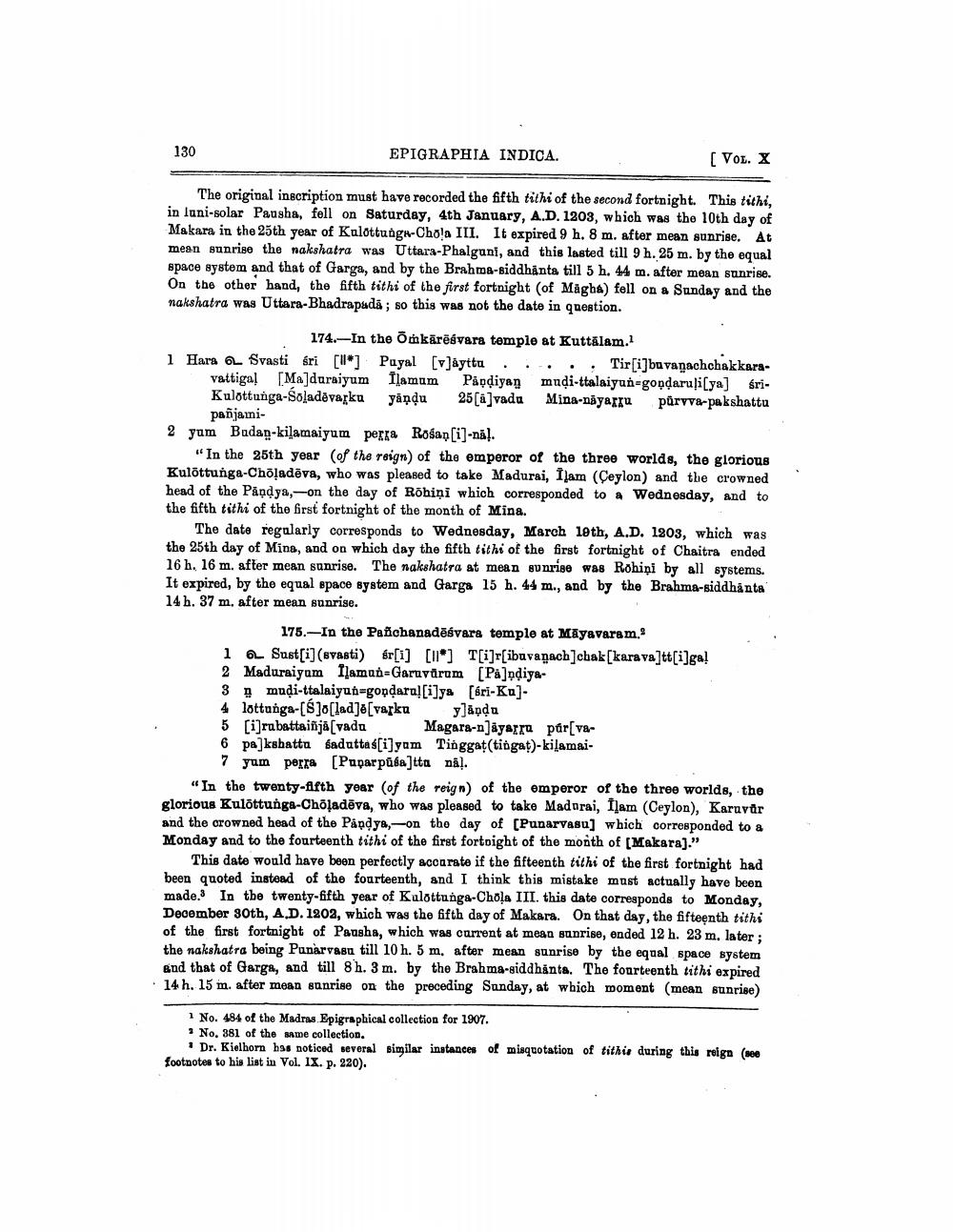________________
130
EPIGRAPHIA INDICA.
( Vol. X
The original inscription must have recorded the fifth tithi of the second fortnight. This tithi, in luni-solar Pausha, fell on Saturday, 4th January, A.D. 1203, which was the 10th day of Makara in the 25th year of Kulottungh-Cho!a III. It expired 9 h. 8 m. after mean sunrise. At mean sunriso the nakshatra was Uttara-Phalguni, and this lasted till 9 h. 25 m. by the equal space system and that of Garga, and by the Brahma-biddhanta till 5 h. 44 m. after mean sunrise. On the other hand, the fifth tithi of the first fortnight (of Māgha) fell on a Sunday and the nakshatra was Uttara-Bhadrapadá; so this was not the date in question.
174.-In the Omkarēsvara temple at Kuttalam. 1 Hara 6. Svasti śri [l*] Payal [v]åytta . .. Tir[i]bavaṇachchakkara
vattiga! [Ma]daraiyum Ilamum Påodiyan madi-ttalaiyun=gondarulisya] sriKulottunga-Soladevaku yandu 25[a]vadu Mina-nāyarzu pūrvva-pakshattu
pañjauni2 yum Budap-kilamaiyum perra Rosan[i]-nal.
"In the 25th year of the reign) of the emperor of the three worlds, the glorious Kulõttunga-Choladēva, who was pleased to take Madurai, Ilam (Ceylon) and the crowned head of the Pandya, on the day of Rohiņi which corresponded to # Wednesday, and to the fifth tithi of the first fortnight of the month of Mina.
The dato regularly corresponds to Wednesday, March 19th, A.D. 1203, which was the 25th day of Mina, and on which day the fifth tithi of the first fortnight of Chaitra ended 16 h. 16 m. after mean sunrise. The nakshatra at mean sunrise was Rohiņi by all systems. It expired, by the equal space system and Garga 15 h. 44 m., and by the Brahma-siddhanta 14 h. 37 m. after mean sunrise.
175.-In the Pañohanadēsvara temple at Māyavaram. 1 6. Sust[i] (svasti) śr[i] [11*] T[i]r[ibuvaṇach]chak[karava]tt[i]ga! 2 Maduraiyam Ilaman-Garuvarum [Pa]pdiya3 mndi-ttalaiyun=gondara[i]ya [ri-Ku)4 lottunga-[6]0[lad]e[varku yladu 5 [i]rubattaisijā(vada Magara-n]āyarra pár[va6 pa]ksbattu saduttas[i]yam Tinggaţ(tingat)-kilamai
7 yum perra [Paparpūba]tta nå! "In the twenty-fifth year (of the reign) of the emperor of the three worlds, the glorious Kulottunga-Chöļadēva, who was pleased to take Madorai, Tlam (Ceylon), Karuvar and the crowned head of the Pandye,-on the day of (Punarvasu] which corresponded to & Monday and to the fourteenth tithi of the first fortnight of the month of [Makara)."
This date would have been perfectly accurate if the fifteenth tithi of the first fortnight had been quoted instead of the fourteenth, and I think this mistake must actually have been made. In the twenty-fifth year of Kalottunga-Chola III. this date corresponds to Monday, December 30th, A.D. 1202, which was the fifth day of Makara. On that day, the fifteenth tithi of the first fortnight of Pausha, which was current at mean sunrise, ended 12 h. 23 m, later; the nakshatra being Panarvasu till 10 h. 5 m. after mean sunrise by the equal space system end that of Garga, and till 8h. 3 m. by the Brahma-siddhanta. The fourteenth tithi expired 14 h. 15 m. after mean sunrise on the preceding Sunday, at which moment (mean sunrise)
1 No. 484 of the Madras Epigraphical collection for 1907. * No. 381 of the same collection,
Dr. Kielhorn has noticed several similar instances of misquotation of tithis during this reign (see footnotes to his list in Vol. IX. p. 220).




